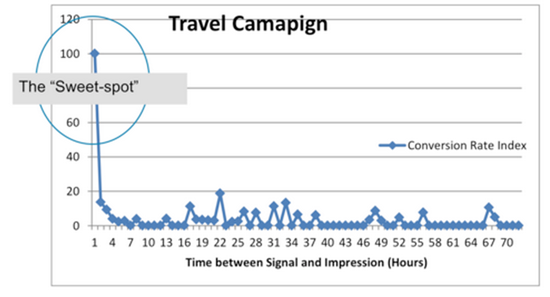A Strategic Guide to Cross-Platform Marketing

Marketers have a multi-device conundrum because the consumers they want to connect with distribute their attention between multiple devices. As connected devices like smartphones and tablets have grown in popularity, marketers have addressed the growth by engaging and acquiring consumer intelligence in silos.
As marketers followed audiences to smartphones, they got to know and engage the smartphone consumer. In just two years from 2011 to 2013, smartphone ownership in the U.S. jumped 22 percentage points from 43 percent to 65 percent. Along the way to 65 percent smartphone ownership, smartphone strategies became a must for marketers.
As marketers followed audiences to tablets, they got to know and engage the tablet consumer. In the two years from 2011 to 2013, tablet ownership in the U.S. jumped 35 percentage points from 13 percent to 48 percent. Along the way to 48 percent tablet ownership, tablet strategies became a must for marketers.
Today, marketers are coming to terms with the fact that they need to merge their view of smartphone consumers, tablet consumers and traditional digital consumers into one holistic view of the multi-device consumer and execute their marketing programs against actual people. Last year, a whopping 37 percent of U.S. consumers owned a laptop, tablet and smartphone and even greater percentages of consumers own two of these three devices.
Pursuing a cross-platform strategy will help marketers link their data intelligence to a 360-degree view of the consumer and focus marketing efforts on what's really important: intelligently and profitably connecting with people.
In 2013, 37 percent of U.S. consumers owned a laptop, tablet and smartphone.
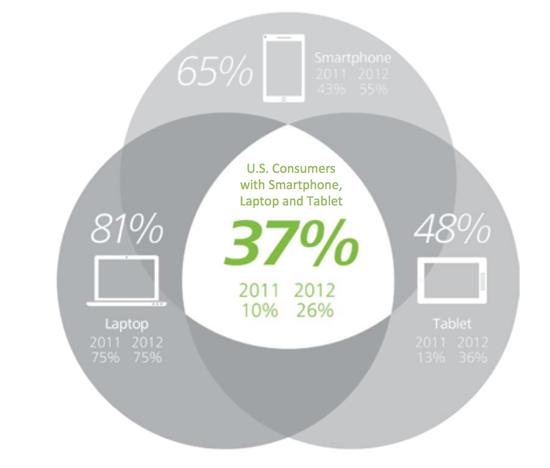
This requires a cross-platform approach to digital advertising whereby each engagement with each individual builds upon prior engagements. A cross-platform approach serves the crucial role of recognizing the same people as they engage from screen to screen to screen.
The cross-platform approach minimizes the disconnect that can happen every time a person engages with a brand from multiple devices. For example, if a person browses an ecommerce site on a tablet, buys from the same ecommerce site on a desktop and takes no action with the ecommerce site from a smartphone, a marketer without a cross-platform approach will see this person as three different people. The person will look like a customer from their desktop, like a visitor from their tablet and like a new user on their smartphone.
This leads to very disconnected messaging. Ads reaching the person's desktop may promote 10 percent off the next purchase, ads reaching the person's tablet may show products the person already bought, and ads reaching the person's smartphone may incorrectly be oriented toward acquiring new customers. This broken view of the customer is bad for the customer experience and a wasteful use of ad spend.
The goals of a cross-platform approach are two-fold. The first goal is to recognize the same people from screen to screen to screen. The second goal is to use the information from the interactions on any one screen to improve the interactions on all other screens. Achieving these goals will eliminate waste, scale data-limited environments and drive greater profitability.
To tackle the multi-device conundrum and pursue a cross-platform approach to digital advertising, marketing leaders should do these 5 things:
1. Aggregate audience data
2. Unify the data into individual personas
3. Activate campaigns that connect with actual people
4. Enhance the CRM system
5. Empower marketing teams to pursue best practices
Let's explore each one of these five recommendations in detail.
1. Aggregate audience data
For starters, marketers need one place where they can collect all their usable (e.g. anonymous, legal and non-PII) data in real-time and build productive segments. At a minimum, this involves using a Data Management Platform (DMP) to pull in first-party website data together with third-party behavioral and demographic data. The more data a marketer aggregates, the more flexibility they have in building their segments. Savvy marketers will build on the minimum data sets with:
- Anonymized customer data from CRM systems
- Second-party negotiated data
- First-party URL shortening and widget sharing data
- Proprietary access to publishers' URL shortening and widget sharing data
With all this data, marketers can build segments that respond to intent signals.
- An auto advertiser can combine behavioral data with sharing data in a segment that reaches in-market auto shoppers and their closest social connections

- A financial services advertiser can combine CRM data with sharing data in a segment that reaches the social connections of existing customers.

- A movie studio can combine first-party website data with sharing data in a segment that targets the social connections of existing fans while excluding the fans themselves.

Immediately, these segments can be used for cookie-based targeting. However, to reach individuals in these segments regardless of what device they're using at a moment of opportunity, marketers need the next step. They need to unify data into individual personas.
2. Unify the data into individual personas
The data in a DMP can be organized using the Web's most popular anonymous unique identifier, the cookie. However, today's multi-device world has several other unique identifiers to account for. Most digital activities on smartphones and tablets tie into one of the three unique identifiers listed here:
Mobile Web cookie
This is a non-permanent, anonymous identifier that works with some mobile Web browsers.
Google's advertising ID (Advertising ID)
This is a resettable, anonymous identifier for apps on Android devices.
Apple's Identifier for Advertisers (IDFA)
This is a non-permanent, non-personal device identifier for apps on iOS devices.
Marketers need a way to link each individual person's multiple anonymous identifiers to just one anonymous identifier, a persona ID. In a marketer's DMP, a single persona ID should link together all the relevant identifiers and associated data for a single person. Ideally, every person in the marketer's target audience will be represented in their DMP by a persona ID. It takes two kinds of matching to get all the different anonymous identifiers associated with all the bits of audience data linked to persona IDs in an organized way.
Deterministic matching uses a shared key to determine an exact link between two or more unique identifiers. When a shared key is personally identifiable, it should always be hashed before it's used for matching. A hashed key is anonymized through encryption, yet stays the same across environments. Hashed keys help consolidate the data while maintaining privacy.
As deterministic matches are made in a DMP, each persona ID starts to describe each member of a marketer's audience more accurately.
Many marketers already have some deterministic data that they can use to consolidate their audience into persona IDs. For example, a bank's customer may login to use banking services on two different devices: on the bank's iOS app and on the bank's website. Using this customer's hashed login name as a shared key, the bank's DMP can link the customer's Web cookie and IDFA to the same persona ID. Now, the unified, anonymous persona ID gives the bank a better view of their customer across online and iOS engagements.
A bank uses deterministic data to create an anonymous, unified view of their customer across online and iOS engagements:
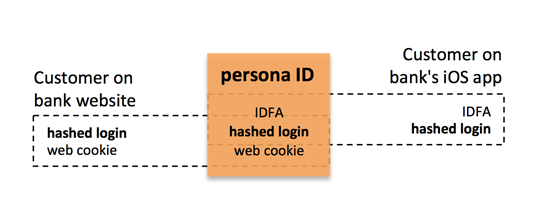
With deterministic matching, a marketer has near 100 percent certainty that different unique identifiers belong to the same person. However, deterministic matching lacks scale. A marketer also needs probabilistic matching in order to consolidate the unique identifiers for all the chunks of information in the DSP that didn't fit a deterministic match.
Probabilistic matching uses a collection of signals to approximate a match of multiple unique identifiers to the same persona ID. It has about an 80 percent certainty of making the right matches. Probabilistic matching requires quality source data and machine learning. Source data can include numerous signals such as IP and timestamp.
To illustrate probabilistic matching, assume that one person uses the same Comcast IP to browse the mobile Web on their smartphone and watch videos on their laptop at similar times of day. A machine learning algorithm could infer that the mobile cookie and the Web cookie from the Comcast IP belong to the same person. From there, a DMP could link the two cookies together into a persona ID.
Together, probabilistic and deterministic matching solves one of the biggest problems behind the multi-device conundrum, which is that of mistaking one person for multiple people. It allows the DMP to organize data by persona ID and therefore recognize the same person from screen to screen to screen. This offers a consolidated view of the marketer's actual audience. With this, the marketer can plan and buy media to connect with actual people.
3. Activate campaigns that connect with people
Once a DMP can recognize the same individuals on multiple devices, a DMP's segments become far more useful and powerful. It's a huge step forward for segments to represent actual people. In addition, the segments are more descriptive of these actual people since now a segment is considering data from all consumer touchpoints. For example, persona-based segments take information from the data-rich Web cookie environment and make it actionable on the data-limited mobile app environment. Similarly, persona-based segments take geo-location information from the mobile app environment and make it actionable on the Web cookie environment.
Marketers that get this far in solving the multi-device conundrum will find it much easier to plan and buy media that targets the actual people they want to reach. However, to take full advantage of audience segments in a DMP, marketers need the DMP to connect in real-time with a Demand-Side Platform (DSP). In addition, the DSP needs to reach all major real-time channels: display RTB, mobile RTB, video RTB, social RTB and mobile push.
Marketers should expect no less than a real-time link between their DSP and DMP. When there's latency between the moment a consumer signals intent and the moment an advertiser responds with an ad, advertising performance suffers. The greater the latency, the bigger the hit on performance. Campaign data from advertisers in the travel and financial services verticals illustrate the importance of acting on intent as immediately as possible. They found the first-hour after a consumer signals intent to be the "sweet spot" in terms of campaign responsiveness and willingness to convert.
A travel advertiser found that 81 percent of all its conversions happened in the "sweet spot." By the second hour after a signal of intent, conversion rates dropped seven times lower.
Travel advertiser earns 81 percent of all conversions from
impressions served within one hour of an intent signal
(Source: RadiumOne data for a travel advertiser)
The same power of acting immediately holds true even for advertisers with longer sales cycles. A financial services advertiser found that 29 percent of all its conversions happened in the "sweet spot." By the second hour after a signal of intent, conversion rates dropped 2.5 times lower.
Financial services advertiser earns 29 percent of all conversions
from impressions served within one hour of an intent signal
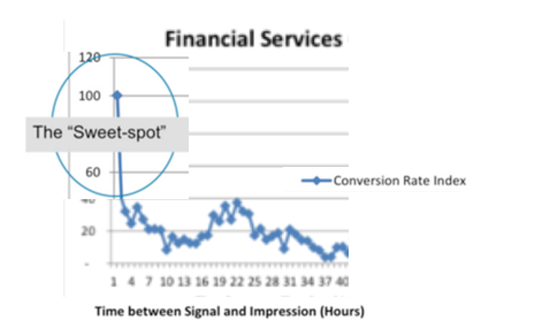
(Source: RadiumOne data for a financial services advertiser)
Since conversions happen so close to intent signals, marketers need systems that activate real-time data about consumers in milliseconds, not minutes or even hours. Some marketers make the mistake of separating their data from its delivery by separating their DMP from their DSP. A stand-alone DMP leads to delayed delivery between the time of an intent signal and the time an ad is served. This results in lost opportunities. To capture the most opportunities from a DMP and DSP, marketers should look for an integrated solution where the DMP and DSP work together in real-time.
Stand-alone DMP leads to delayed delivery and lost opportunities

Integrated DSP/DMP powers real-time delivery and high performance advertising

The real-time connection between DMP and DSP makes it easy to connect with individuals wherever they consume digital content. The integrated DMP/DSP can see an intent signal, match it to a persona ID in real-time, and act on it by serving the individual an ad, regardless of device. For the most flexibility in activation, the integrated DMP/DSP should be able to reach individuals via display RTB, mobile RTB, video RTB, social RTB and mobile push. With this, the integrated DMP/DSP can find and reach consumers with great flexibility on many devices and within many channels.
The ideal real-time digital marketing stack has an integrated DMP/DSP and RTB activation on many devices and within many channels:
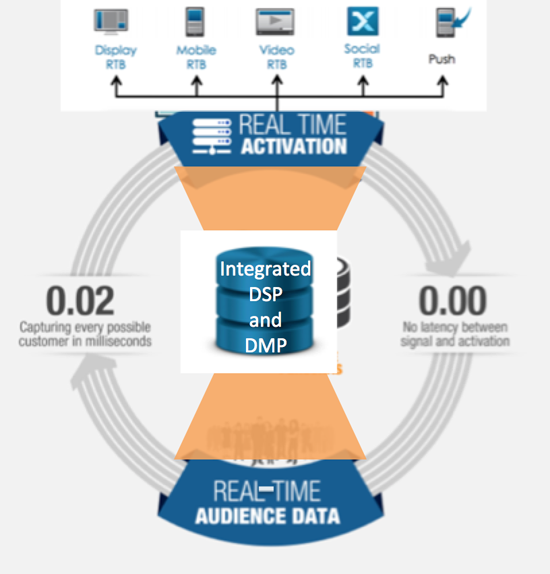
Returning to an earlier scenario, what would a retail marketer want to happen when a person browses their ecommerce site on a tablet and then leaves?
Naturally, the marketer would want their digital marketing stack to quickly reach the person with an ad that brings them back to the ecommerce site to purchase. It would work like this. The DMP will use first-party website data in real-time to see that a person left the ecommerce site from their tablet without buying. The DMP will have a persona ID for this person and so it will add the persona ID to a retargeting segment. The persona ID in the segment will tell the DSP how to retarget the individual regardless of device. By operating in real-time with no latency between signal and activation, the DSP finds the next possible opportunity to reach the individual within an hour through an ad served to the person's Facebook news feed on the person's laptop. The person clicks the ad in the news feed, returns to the ecommerce site from their laptop, not their tablet, and converts. The integrated DMP/DSP scores a conversion.
Excellent, the integrated system did its job. However, it could also amplify the intent signal to a social graph. With retargeting, one intent signal can only drive a maximum of one conversion. With the right amplification, one intent signal can drive many conversions.
What if the person in the last example is a college student looking for camping gear for an upcoming fraternity camping trip? When the college student leaves the tablet site, instead of just triggering retargeting, the integrated DMP/DSP could amplify the intent signal to retarget the college student and target other likely campers in his social graph. Now, the camping website has turned one conversion opportunity into many conversion opportunities. Marketers should look for technology partners with proprietary data and experience with amplifying intent signals to a social graph.
4. Enhance the CRM system
From social graph data and beyond, the DMP is a powerful aggregator of customer insights. Marketers commonly enhance their DMP with CRM data. However, marketers can also expect the reverse, to enhance their CRM with DMP data. This helps marketers personalize the customer experience and get deeper customer insights.
When marketers use their DMP to enhance CRM, they enhance all the channels that CRM influences. This includes email, website, social and call center activities. For example, DMP data can enrich the decisions made to customize content on websites, email newsletters or even on call center interactions.
The ideal real-time digital marketing stack does CRM onboarding and CRM enhancement:
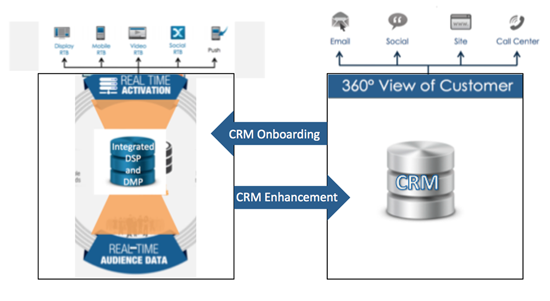
Clearly, a comprehensive cross-platform approach to digital advertising empowers more personalized and effective marketing beyond RTB execution channels. Trends point toward the DMP becoming as foundational to an enterprise as the CRM system is today. So, it's important for marketing leaders to pursue excellence in this area.
5. Empower marketing teams to pursue best practices
Marketing leaders can pursue cross-platform excellence by empowering their teams to pursue best practices. The following three best practices are a good place to start:
1. Dedicate resources for a successful implementation of the DMP and DSP
A marketer's technology partner for their DMP/DSP will do most of the implementation work. However, there are a few things that must be implemented by the marketer. This includes site tagging and policy updates. Site tagging powers the feedback loop that informs a DSP's real-time media buying decisions. At the outset of implementing a DMP/DSP, the best practice is to assign skilled project managers and Web developers to site tagging so that it gets done quickly and accurately. Also, implementing a DMP/DSP usually involves policy changes that need to undergo legal review and consumer notification. The best practice here is to have an executive sponsor from a corporate communications or legal team to help with this. Luckily, site tagging and policy changes are one-time projects that marketing teams can tackle upfront.
2. Integrate digital planning and buying
Once an integrated DMP/DSP makes it possible for marketers to recognize and engage the same person from screen to screen to screen, there's no excuse for not having fully integrated planning and buying. As a best practice, marketing teams should embrace integrated planning and buying as they adopt the integrated DMP/DSP. It will take some time for marketers to orient their processes around reaching individuals. Marketing leaders can support their teams by growing the team's experience with cross-platform advertising and encouraging ongoing learning.
3. Invest in great creative
Finally, marketers need to fully appreciate that the individuals they want to reach could pop up anywhere. Marketers will need high-impact creatives for display RTB, mobile RTB, video RTB and social RTB to fully capitalize on cross-device capabilities.
The solution to the cross-device conundrum is close at hand. One way to get there fast is to work with a technology partner with extensive cross-device and cross-platform capabilities.
Act Now
The multi-device conundrum has reached a point where inactivity is not an option. In 2013, 37 percent of U.S. consumers owned a laptop, tablet and smartphone. Multi-device ownership and usage will continue to rise. As it rises, marketers who don't act now will find it harder and harder to spend their media dollars wisely.
The rewards of cross-platform advertising are close at hand. Marketers can quickly eliminate waste, scale data-limited environments and drive greater profitability. They simply need the ability to recognize the same people from screen to screen to screen and use the information from the interactions on any one screen to improve the interactions on all other screens.
Luckily, marketers have a clear path to action. Marketing leaders should invest in doing these five things:
1. Aggregate audience data
2. Unify the data into individual personas
3. Activate campaigns that connect with people
4. Enhance the CRM system
5. Empower marketing teams to pursue best practices
Subscribe to Our Newsletter!
Latest in Marketing








